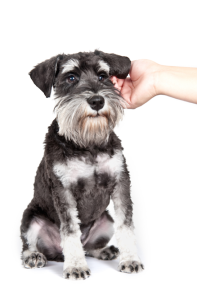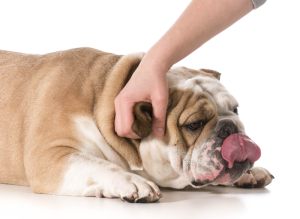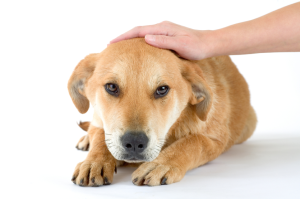 We’ve all heard of the many health benefits of owning a dog; from reducing our blood pressure and heart rate to increasing our immune system. Being in the presence of a dog or better, touching and petting a dog is both soothing and relaxing. But how does it feel to the dog? Can we be sure that our furry companion equally benefits from our friendly touches? Dogs use physical contact with one another to show affection, but also to provoke or intimidate, so how can we make sure we don’t send the wrong message? More studies today show that although dogs appreciate physical contact with us, we can often be rude in the way that we pet a dog, forcing our pets to put up with repeated discomfort. Even with the best of intentions, we can unknowingly trigger negative emotions in the dog. A pat on the top of the head, a belly rub, a scratch behind the ear, may all feel equally pleasurable to us, but they are certainly not experienced in the same way by the dog. In a recent study, the physiological and behavioral responses in dogs was measured to assess which touches feel good to the dogs and which ones do not (Kuhne & al., 2014).
We’ve all heard of the many health benefits of owning a dog; from reducing our blood pressure and heart rate to increasing our immune system. Being in the presence of a dog or better, touching and petting a dog is both soothing and relaxing. But how does it feel to the dog? Can we be sure that our furry companion equally benefits from our friendly touches? Dogs use physical contact with one another to show affection, but also to provoke or intimidate, so how can we make sure we don’t send the wrong message? More studies today show that although dogs appreciate physical contact with us, we can often be rude in the way that we pet a dog, forcing our pets to put up with repeated discomfort. Even with the best of intentions, we can unknowingly trigger negative emotions in the dog. A pat on the top of the head, a belly rub, a scratch behind the ear, may all feel equally pleasurable to us, but they are certainly not experienced in the same way by the dog. In a recent study, the physiological and behavioral responses in dogs was measured to assess which touches feel good to the dogs and which ones do not (Kuhne & al., 2014).
As social creatures, we like being touched and hugged. Being hugged by a loved one or by a stranger however, feels very different. Just because we might appreciate holding our spouse’s hand doesn’t mean that we’d like to do the same with the neighbor. Why would it be any different for dogs? Not a day goes by without someone asking to pet my dog. When taking service dogs out in public places, kindly but assertively coaching people on how to interact with a dog is an intrinsic part of the job. Dogs are magnets to other dog lovers and since service dogs are expected to be friendly, many see an opportunity for petting. Few however understand the effects of their behavior on the dog. What does it feel like to a dog when a stranger leans over them and pets them on the head? The dog is rarely given the choice to interact or not and is expected to put up with the intrusive human.
In a recent study, 28 dogs of different breed, age and background were evaluated while they were touched in 9 different ways (for 30 seconds at a time) by a stranger (Kuhne & al., 2014):
 Petting the dog on his shoulder
Petting the dog on his shoulder- Petting the dog on the lateral side of the chest
- Petting the dog on the ventral part of the neck
- Petting and holding the lying dog on the ground
- Holding a forepaw of the dog
- Petting the dog on the top of the head
- Scratching the dog at the base of the tail
- Holding the dog on his collar
- Covering the dog’s muzzle with one hand.
When petted on the head, the shoulder, or a paw, the dogs showed appeasement signals and redirected behaviors, signs that the dogs were uncomfortable with the physical contact. When the stranger mildly constrained the dog, for example, gently holding the dog on the ground, grabbing the collar or covering his muzzle with one hand, the dogs showed increased freezing and displacement behaviors such as lifting a paw, looking or moving away and licking the lips. In all these cases, the dogs’ heart rates also increased as a clear sign of stress. Shaking and stretching right after they were touched, was also a sign of relief once the interaction was over, another indication that the dogs were not enjoying the interactions. Petting on the chest however, was associated with a decrease of heart rate, and was more calming to the dog.
 Even dog owners often fail to recognize their own dogs’ subtle stress signals. A head turn, a quick lick of the upper lip, a freeze, often go unrecognized as the dog’s expressions of discomfort. Consequently, the relationship between dogs and their humans can sometimes be difficult and even become dangerous over time. We might assume that if a dog owner touches his own dog in the same ways, the dog would not be affected negatively. Surprisingly, in a similar study, when the dogs were petted and touched by their owners, they displayed displacement signals for even longer periods of time than when touched by a stranger (Kuhne & al., 2012). It’s possible that the results in this situation were a reflection of the dog/human relationship. Due to the history of repeat stressful manipulations the dogs had become now sensitized to the discomfort of their owner’s touches.
Even dog owners often fail to recognize their own dogs’ subtle stress signals. A head turn, a quick lick of the upper lip, a freeze, often go unrecognized as the dog’s expressions of discomfort. Consequently, the relationship between dogs and their humans can sometimes be difficult and even become dangerous over time. We might assume that if a dog owner touches his own dog in the same ways, the dog would not be affected negatively. Surprisingly, in a similar study, when the dogs were petted and touched by their owners, they displayed displacement signals for even longer periods of time than when touched by a stranger (Kuhne & al., 2012). It’s possible that the results in this situation were a reflection of the dog/human relationship. Due to the history of repeat stressful manipulations the dogs had become now sensitized to the discomfort of their owner’s touches.
So how can we make sure we’re not being rude to the dog?
- It’s always best to let the dog initiate the contact rather than invading his/her space. Some dogs need a few seconds or minutes before they feel comfortable enough to come close and accept being touched.
- Pet the dog gently on the chest or behind the ear closest to you. In all cases, avoid any petting over or across the dog. Never hug the dog. Stop after a few seconds and see if the dog asks for more or on the contrary shows signs of relief and avoidance.
- Watch for any displacement or stress signals: freezing, looking away, licking of the lips, yawning, whale eye, lifting of a paw, tail tucked, ears back, urination. If the dog displays any of them, back off and give him/her space.
- When it’s your own dog, take the time to desensitize your dog to unavoidable restrains. Grab the collar for instance, and give the dog a treat. Grab the dog’s paws, tail, ear, etc… and give a treat. For more information on how to desensitize the dog to potentially unpleasant manipulations, you can refer to the blog ‘The importance of preparing animals for the vet‘
- When the dog isn’t yours, always ask his/her human before interacting with him/her.
When we consider petting as a way to reward a dog for performing a behavior, we have to keep in mind that some petting may be felt as pleasant, while others might trigger negative emotions. When that happens, our displays of affection, a ‘good boy’ with a friendly tap on the head, may actually be punishing the behavior. When we fail to recognize how the dog truly feels about the intended ‘reward’, it’s easy then to label the pooch as stubborn when after many repetitions, he/she’s still not willing to respond as asked. This is one more reason to favor the use of treats in training over praise and petting. As always, being mindful of the impact we have on the animal is key. All dogs are different, when some enjoy a vigorous pet, others might get stressed or even scared. When we understand how physical contact can impact our pet, we can develop a more positive relationship based on mutual respect and affection.
Jennifer Cattet Ph.D.


A nicely done article that I’m going to link and share. On that topic, a few things come to mind. On top of head petting, it seems very difficult to break many people of that habit. So dogs who come through here are all checked and, if needed, desensitized to that behavior. Some will still not like it, but they at least learn how to deal with it. Some will simply move away, but without getting upset. I’m glad you included a note on that aspect.
I’ve also compared their response between head petting (with hand coming down from above), and starting under the ear or muzzle, then moving up to slowly rub the head (not rough petting). I found that most unrestrained dogs show enjoyment and stand in place, while they may move away for the former.
As for starting on the chest or behind the ear, there I’ll differ. I’ll always start slowly under the muzzle only. That also gives you the least physical extension into the dog’s space (safer), and allows them to easily respond by just turning their head away.
Oh boy, is that ever true (about being hard to break people of the habit of head petting). I have a mini poodle with a fluffy head that people love to put their hand on. Fortunately, it does not seem to bother him at all. He is a therapy dog and works with children at libraries and with adults with developmental and intellectual disabilities, so it’s a great thing that he’s okay with head petting.
When we’re relaxing on the couch, I rub his chest by making circles with all of my fingers together. He goes right to sleep. Great article!
Thank you for this very important and informative article. I don’t pet my dog on the head, vut she likes to be scratched everywhere else as she often lifts up my hand with her head for me to scratch more! 🙂
Never hug the dog? Why not? I’ve been doing that for years, I hope it hasn’t hurt her. I feel guilty
The article here applies well to unknown dogs. However, over time, dogs just as people will find various new things they like and dislike. Sometimes they may just put up with something, but try stopping in the middle and see what your dog does. If he prompts you to continue, you may have his answer.
Wonderful article. Sharing on Facebook and Twitter. Thank you!
I think dogs have great sence of knowldge who loves them & who is not. i am now a guest with a family who have German Shiphered Dog , we get along from day one & she like petting in different areas i think , well after reading this i will be more observing about how she reacts to my petting , wish i don’t do any harm cux i libe her so very much & all my petting are acts of love no more no less.
My dog was groomed on Monday 3 days later he bite me trying to move him of my lap asleep he’s been acting strange since the grooming ears back head down he’s never bite me before he’s 15 months old now and had him since a pup is it something I have done. I have taken him the vets and there is nothing medical wrong with him . please could you give me some advice thanks Sharon
My son and I have rescued an initial twelve dogs from Afghanistan and acquired two more after the initial twelve. He has two of them and I have one, the members of his infantry company have the others in their homes.
The two my son has were very leery of petting and handling and over time crave being pet all over, rolling over for belly pets. My dog is a Moscow Watchdog. when we got him, he was skin and bones and hated the world. He was introduced to the pack of various rescues living with us, total of seven dogs.
He had to be fed in a separate closed room and did not want to be touched. It took pretty much a year to gain his trust. I cook for my dogs and constantly fed him. With much patience and just letting him do his own thing he started coming around. As my other pets got old and passed I now have him and a miniature long haired hot doggie. It is funny to watch this giant watchdog interact with his little buddy.
Our giant baby, Whiskey has become the best doggie ever. He is always by either my wives side or mine. He craves our touch, rolling over constantly for his belly rubs and whole body rub downs. Heaven forbid if we stop!! He will roll over on top of us and want more interaction. I could not find a more loyal and loving pet now. He wants his hugs and he knows what give me a kiss means by bringing his nose up to be kissed when I say give me a kiss. This beautiful pet was scheduled to be put to sleep if we didn’t take him. This was the best move I made. He has a huge fenced in yard to play in, tons of toys along with a doggie door to come and go as he pleases. At seventy, I have not been without a dog during my life time, except during my two year service in Viet Nam as a paratrooper. He also insists on going for a ride in the car at least once a day. We live down the NJ shore and he heads to the garage door letting me know it is ride time. Right around the corner is the bay and he loves the car ride there barking at all the wild live on the way. I also walk him down my desolate street so he may lead the way clearing the area of other animals. I am retired so all my time is spent with my best pal. When we first got him, I was bitten twice, as was my son and wife and constant feeding and just letting him do his own thing paid off. While in the house with my wife and I, he has to lay across our feet, constant touch and loving eyes is the order of the day. We love our giant that looks like a St. Bernard and know he would keep strangers away from us.
Whiskey accepts company in the home but needs to sniff them first while also looking at us for direction. Once he feels comfortable with company he then heads to our side heeling and leaning up against my leg. He is just the best pal ever. Time, food, low loving voice and allowing him to dictate to us his desires now produced a pal that craves our touch and calming voice. I love when he puts his giant head under my neck wanting me to lay my head on top of him while giving him hugs, kisses and rub down. We love our buddy and we know he loves us also. I guess he realized he was scheduled to meet his maker and we weren’t about to let that happen!!!!
Most dogs I’ve petted don’t mind having my fingers running over the fur on their head.